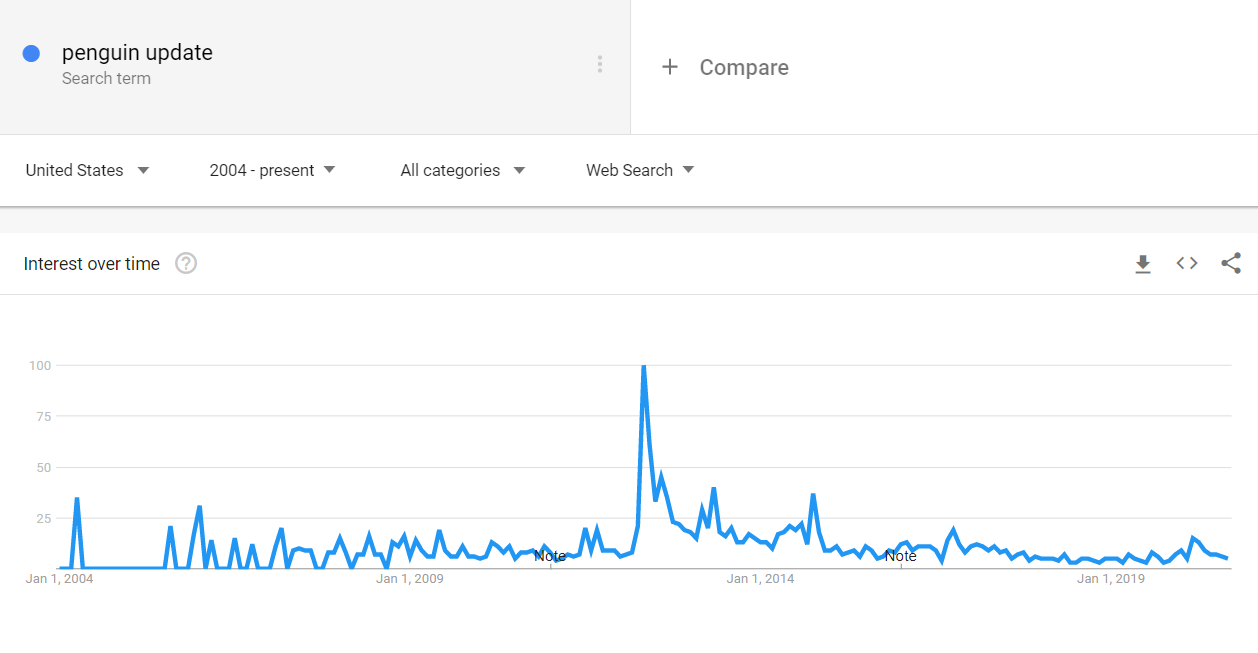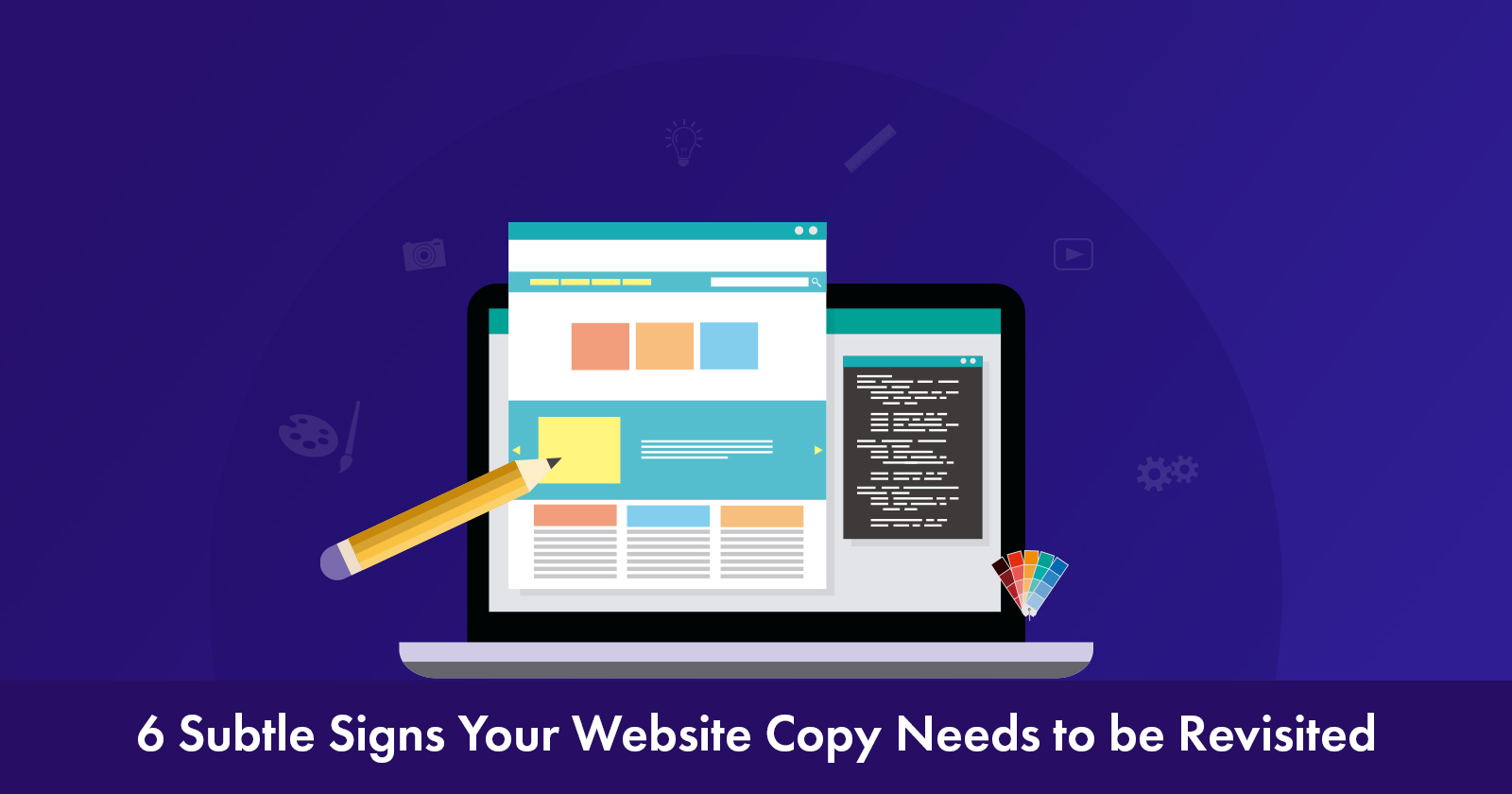Copy is the unsung hero of websites.
All too often, text gets pushed by the wayside in favor of flashy images and fancy design trends.
When push comes to shove, a website with no copy is little more than a jumble of pictures and a color scheme.
Moreover, subpar copy will devalue a website – no matter how nice the design features are.
The realization that it’s time to update your web copy doesn’t always feel like a kick in the rear.
While not getting leads or having insanely high bounce rates are a couple of the glaring signs, many indicators don’t meet the eye.
In this post, you’ll discover six signs that it’s time to take a step back and re-examine your website copy.
1. Keyword Trends Are Making Your Web Copy Obsolete
Monitoring keyword trends and updating content should be common practice for any SEO professional.
But for those who haven’t updated their copy in a few years, there’s a good chance that some of the keywords you had originally included are no longer driving the interest they used to.
Think about it this way:
The keywords “penguin update” or “penguin update recovery” were goldmines to SEO agencies back in 2012.
But the heyday of those terms is long gone – and having them in your website copy obviously isn’t attracting the same interest.

A current example would be related to Adobe BC.
As you’ve probably read, Adobe is shutting down Business Catalyst in March 2021.
That said, if you specialize in building sites hosted on BC – or are offering BC migrations services, any copy you have around these keywords will soon be old news.
Keyword trends are constantly changing, and your web copy needs to be based around how they influence your industry.
Now, this is not to say that you have to change up your copy every week.
But to make the most of it, you are wise to keep close tabs on search trends – or have an expert do so – to ensure your site is always delivering the most timely, relevant message.
2. Customer Pain Points Have Changed
“You’re not selling products and services, you’re selling solutions to problems.”
This is the first thing teachers tell you in any business class.
When writing website copy, selling solutions is not the primary goal.
Instead, you need to sell your understanding of the problem.
The better you are at demonstrating empathy with your clients’ pain points, the easier it will be to sell the solution.
In using web copy to present pain points, the magic lies in the details.
Say you have an IT client that offers cybersecurity services.
Having your web copy say some blanket statement like “cybersecurity is hard” doesn’t do anything to empathize with the problem clients are currently facing.
Fly fishing is hard. Landing a helicopter is hard. Running a marathon is hard.
To properly address relevant pain points, you need to get down and dirty in understanding what’s going on right here and now.
In the cybersecurity example, the problems businesses are facing look a lot different today than they looked just a year ago.
For example, COVID-19 and the rapid transition to remote work setups opened the door for a number of new cybercrimes.
Almost overnight, the pain point for many businesses shifted from protecting on-site servers to protecting employees’ home setups from data breaches.
IT sites across the world needed to adjust their web and sales copy to convey the new cyber danger and its seriousness – as well as present themselves as an expert solution.
Depending on your industry, the finer details of the problems you and/or your clients face will evolve – and your web copy needs to reflect them.
3. The Solutions You Provide Have Evolved
Failing to keep your web copy in-tune with your solutions is easier than you think.
When this happens, you could potentially be leaving money on the table.
For example, say that one of your clients does tree servicing in Northern California.
In recent years, Northern California has been plagued by wildfires.
That said, the client’s offerings would likely evolve to offer wildfire cleanup and land clearing – as these services are certainly in high demand.
Depending on your niche, there’s a good chance your offerings – and consumer demand – will expand as your business grows.
Are a lot of your SEO clients asking for blog writing services? Video SEO? Reputation management?
As you work to meet your client’s evolving needs, updating your web copy to reflect this needs to be done immediately.
4. Your Competitors Are Outshining You
This one requires a bit of critical self-reflection.
Take a good hard look at your website copy, then compare it side-by-side to the copy of your top competitors.
- Does it present your clients’ pain points in a more convincing way?
- Is it more empathetic to your clients’ needs?
- Does it have a more defined personality?
- Does it make their brand seem more credible and trustworthy?
- Do their service offerings go into greater detail than yours?
- Is it simply better than yours?
Be honest with yourself here.
Trust your gut.
Website copy is one of the most important aspects of a website.
Its job is to empathize with the problem, present the solution, and showcase why you are the best company to provide that solution.
If the copy on your competitors’ website is doing a better job of this, they are leaps and bounds ahead of you.
5. Your Brand Voice No Longer Resonates
A brand guide is not written in stone.
Brands evolve.
They update their logo, their color schemes, their voice, and the feel they want to create.
Take Old Spice for example.
Before 2008, Old Spice hadn’t done much to change up its branding in nearly 70 years.
As a result, the company was struggling to resonate with younger demographics – as the products were largely marketed as a sophisticated deodorant for older gentleman.
This all changed with the “Swagger” campaign.
Partnered with Wieden + Kennedy, Old Spice threw out the playbook and rebuilt the brand image from the ground up.
While sticking to the same roots in classiness and manliness, Old Spice completely changed up their style guide and voice to resonate with younger customers.
You’ve probably seen some of their bizarre (yet memorable) ads on TV.
The bottom line is this:
Brand voices have a shelf life.
Sooner or later, yours – or your clients’ – is going to feel stale, outdated, and no longer in tune with the customers you want to attract.
Understand who your current customers are (or need to be).
See how they interact with brands and what type of messaging lights a fire under them.
If your website copy doesn’t match up with your findings, it’s time to revisit it.
6. The Original Copy Was Written on a Shoestring Budget
For startups and small businesses working on a razor-thin budget, copy is usually the component that gets sourced for bottom dollar.
Plain and simple, exceptional wordsmithing doesn’t come cheap.
You may look at a witty headline or paragraph on a Fortune 500 website and think “Oh, I could type something like that up in five minutes!”
In reality, a professional (well-paid) copywriter and brand strategist likely spent hours coming up with hundreds of text variations, did several rounds of revisions, and faced a bunch of rejection along the way.
When you created your website, it may have seemed like a viable option to source a freelance writer to create your web copy for $10/page.
Ninety-nine times out of 100, the results aren’t going to knock your customers’ socks off – to put it lightly.
Always remember, your website is the digital nucleus of your business.
If you’ve got a bigger budget than you had the first time around, investing in professional, succinct copy is something that will certainly pay off.
How Often Should You Update Your Website Copy?
This is a tough one – and there is no solid answer written in stone.
Updating website copy is a task that’s super easy to sweep under the rug – especially if your website is getting decent traffic and leads.
I mean, why fix something that isn’t broken, right?
In addition to the six signs listed above, you need to consider that search engine algorithms are constantly being refined.
As a result, the way they interpret website copy changes.
Additionally, trends in web design tend to dictate how much – or how little – copy is ideal for a webpage.
You need to be keeping a keen eye on the trends in SEO, web design, consumer preferences, and how your industry is evolving.
- Is there a better way to arrange the copy on your website?
- Can you include keywords and other SEO elements in a way that better appeals to users and search engine bots?
Truth be told, there are many reasons to update your copy – even if everything seems peachy on your website.
As a general rule of thumb, try to re-visit your website copy at least once every two to three years.
Even if there are no glaring red flags, simply re-reading the text will more than likely end in some minor tweaks to improve the flow and value.
Update Your Web Copy
Website copy rarely gets the love it deserves.
To sound like a broken record, weak copy makes everything else on your website look weak.
Ultimately, investing your time, budget, and dedication into the text on your website is one of the smartest business decisions you can make.
Hopefully, this post has lit a fire under you to take another look at your web copy.
If it’s been a dog’s age since the last update, it may very well be time for a revamp.
More Resources:
- Content Marketing: The Ultimate Beginner’s Guide to What Works
- Features vs. Benefits: How to Hit Your Content Marketing Sweet Spot
- Top 8 Essential Website Optimization Strategies
Image Credits
Featured Image: Created by author, September 2020
Screenshot taken by author, September 2020




